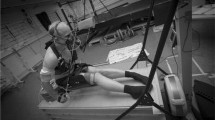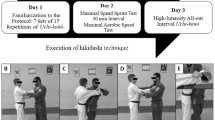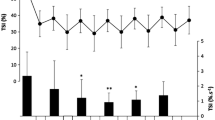Summary
The purpose of this investigation was to compare anaerobic and aerobic components measured during arm exercise in sprint and middle-distance swimmers and to investigate whether the peak anaerobic power :peak aerobic power ratio (W an, peak :W aer, peak) was related to specialization for the event and to performance. TheW an, peak force at zero velocity (F 0), and velocity at zero-force (ν0),W aer, peak, peak oxygen uptake (\(\dot V\)O2peak), and ventilatory threshold (Th v ) were compared during arm exercise tests in sprint (group I,n = 8) and middle-distance (group II,n = 9) competitive male swimmers. Anaerobic indices were estimated by the force-velocity test, an anaerobic test using incremental braking forces; aerobic indices were measured during an incremental aerobic exercise test (30 W · min−1). TheW an, peak andW aer, peak were greater in group I [828 (SEM 70) W; 236 (SEM 12) W] than in group II [678 (SEM 28) W; 230 (SEM 5) W], but the differences were not significant. There were also no significant differences observed between the mean values ofF 0, ν0,\(\dot V\)O2peak, and Th v . TheW an, peak:W aer, peak, however, was significantly higher in sprint swimmers (t = 3.08,P < 0.01). In seven of the swimmers, who had recently performed both the 100-m and 400-m front crawl, a relationship existed between their swim time and theW an, peak:Waer,peak (100m:r = −0.80,P<0.05 and 400m:r=+0.75,P<0.05). In conclusion, during arm-crank exercise, we did not observe significant differences in anaerobic and aerobic components between sprint and middle-distance swimmers. However, the results of the present study demonstrated the usefulness of theW an, peak :W aer, peak in the physiological evaluation of swimmers as it reflects the proportion of anaerobic to aerobic systems involved in the supply of energy.
Similar content being viewed by others
References
Åstrand PO, Saltin B (1961) Maximal oxygen uptake and heart rate in various types of muscular activity. J Appl Physiol 16:977–981
Åstrand PO, Rodahl K (1970) Textbook of work physiology. McGraw-Hill, New York
Åstrand PO, Engström L, Eriksson B, Karlberg P, Nylander I, Saltin B, Thoren C (1963) Girl swimmers with special reference to respiratory and circulatory adaptation and gynaecological and psychiatric aspects. Acta Paediat [Suppl] 147:4–70
Bar-Or O, Zwiren LD (1975) Maximal oxygen consumption test during arm exercise-reliability and validity. J Appl Physiol 38:424–426
Bonen A, Wilson BA, Yarkony M, Belcastro AN (1980) Maximal oxygen uptake during free, tethered, and flume swimming. J Appl Physiol 48:232–235
Caiozzo VJ, Davis JA, Ellis JF, Azus JL, Vandagriff R, Prieto CA, McMaster WC (1982) A comparison of gas exchange indices used to detect the anaerobic threshold. J Appl Physiol 53:1184–1189
Cazorla G, Mompetit R (1983) Niveau d'entraînement et spécificité de la consommation maximale d'oxygène chez le nageur. Motri hum 1:50–55
Costill DL (1983) Muscle fibre types. In: Troup J, Reese R (eds) A scientific approach to the sport of swimming. Scientific Sports, Gainesville, Fla., pp 14–16
Costill DL, Rayfield F, Kirwan JP, Thomas R (1986) A computer based system for the measurement of force and power during front crawl swimming. J Swim Res 2:16–19
Davies CTM, Sargeant AJ (1974) Physiological responses to standardized arm work. Ergonomics 17:41–49
Davis JA, Vodak P, Wilmore JH, Vodak J, Kurtz P (1976) Anaerobic threshold and maximal aerobic power for three modes of exercise. J Appl Physiol 41:544–550
Hawley JA, Williams MM (1991) Relationship between upper body anaerobic power and freestyle swimming performance. Int J Sports Med 12:1–5
Holmér I (1972) Oxygen uptake during swimming in man. J Appl Physiol 33:502–509
Holmér I (1974) Physiology of swimming man. Acta Physiol Scand [Suppl] 407:9–47
Holmér I, Åstrand PO (1972) Swimming training and maximal oxygen uptake. J Appl Physiol 33:510–513
Holmér I, Lundin A, Eriksson BO (1974) Maximum oxygen uptake during swimming and running by elite swimmers. J Appl Physiol 36:711–714
Louhevaara V, Smolander J, Tuomi T, Korhonen O, Jaakkola J (1985) Effects of an SCBA on breathing pattern, gas exchange, and heart rate during exercise. J Occup Med 27:213–216
Louhevaara V, Sovijärvi A, Ilmarinen J, Teräslinna P (1990) Differences in cardiorespiratory responses during and after arm crank and cycle exercise. Acta Physiol Scand 138:133–143
Magel JR, Faulkner JA (1967) Maximum oxygen uptakes of college swimmers. J Appl Physiol 22:924–928
Magel JR, Foglia GF, McArdle WD, Gutin B, Pechar GS, Katch FI (1975) Specificity of swim training on maximum oxygen uptake. J Appl Physiol 38:151–155
McArdle WD, Glaser RM, Magel JR (1971) Metabolic and cardiorespiratory response during free swimming and treadmill walking. J Appl Physiol 30:733–738
Mercier J, Mercier B, Prefaut Ch (1991) Blood lactate increase during the force velocity exercise test. Int J Sports Med 12:17–20
Obert P, Falgairette G, Bedu M, Coudert J (1992) Bioenergetic characteristics of swimmers determined during arm-ergometer test and during swimming. Int J Sports Med 13:298–303
Sawka NM (1986) The physiology of upper body exercise. Exerc Sport Sci Rev 14:175–211
Secher NH, Ruberg-Larsen N, Binkhorst RA (1974) Maximal oxygen uptake during arm cranking and combined arm plus leg exercise. J Appl Physiol 36:515–518
Sharp RL, Troup JP, Costill DJ (1982) Relationship between power and sprint freestyle swimming. Med Sci Sports Exerc 14:53–56
Thorland WG, Johnson GO, Cisar CJ, Housh TJ, Tharp GD (1987) Strength and anaerobic responses of elite young female sprint and distance runners. Med Sci Sports Exerc 19:56–61
Troup J, Reese R (1983) Physiological aspects of swimming performance: In: Troup J, Reese R (eds) A scientific approach to the sport of swimming. Scientific Sports, Gainesville, Fla., pp 3–59
Vago P, Mercier J, Ramonatxo M, Préfaut Ch (1987) Is ventilatory anaerobic threshold a good index of endurance capacity? Int J Sports Med 8:190–195
Vandewalle H, Pér`es G, Monod H (1983) Relation force-vitesse lots d'exercices cycliques réalisés avec les membres supérieurs. Motri Hum 2:22–25
Vandewalle H, Pérès G, Heller J, Panel J, Monod H (1987) Force-velocity relationships and maximal power on a cycle ergometer. Eur J Appl Physiol 56:650–656
Vandewalle H, Pérès G, Soubarié B, Touvenel O, Monod H (1989) Force-velocity relationship and maximal power during cranking exercise in young swimmers. Int J Sports Med 10:439–445
Vokac Z, Bell E, Bautz-Holter E, Rodahl K (1975) Oxygen uptake/heart rate relationship in leg and arm exercise, sitting and standing. J Appl Physiol 39:54–59
Wasserman K (1978) Breathing duration exercise. New Engl J Med 298:780–785
Wasserman K, Van Kassel AL, Burton GG (1967) Interaction of physiological mechanisms during exercise. J Appl Physiol 22:71–85
Yoshida T, Udo M, Iwai K, Chida M, Ichioka M, Nakadomo F, Yamaguchi T (1990) Significance of the contribution of aerobic and anaerobic components to several distance running performances in female athletes. Eur J Appl Physiol 60:249–253
Author information
Authors and Affiliations
Rights and permissions
About this article
Cite this article
Mercier, B., Granier, P., Mercier, J. et al. Anaerobic and aerobic components during arm-crank exercise in sprint and middle-distance swimmers. Europ. J. Appl. Physiol. 66, 461–466 (1993). https://doi.org/10.1007/BF00599622
Accepted:
Issue Date:
DOI: https://doi.org/10.1007/BF00599622




